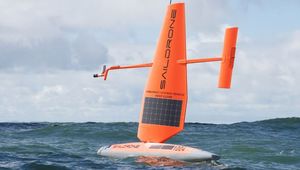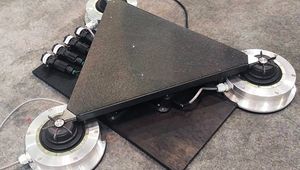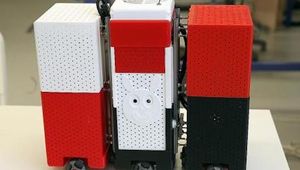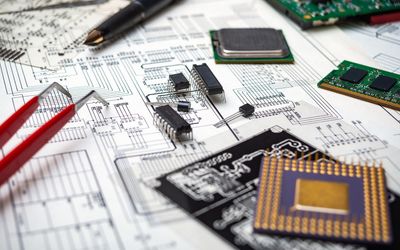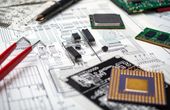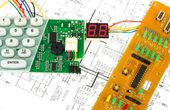Arduino Portenta X8
An industrial-grade hybrid combination of microprocessor and microcontroller board.
General
| Product Type | Microprocessor |
| Applications | IoT & Smart Systems |
| Key Features | USB connector |
Technical Specifications
| Dimensions | 25.40mm (W) x 66.04mm (L) |
| Weight | 10.2 g |
| Processor | NXP® i.MX 8M Mini - 4x ARM® Cortex® -A53 core up to 1.8GHz, 1x ARM Cortex -M4 core up to 400 MHz |
| Microcontroller | STMicroelectronics STM32H747AII6 Dual ARM® Cortex® M7/M4 IC - 1x ARM Cortex -M7 core up to 480 MHz 1x ARM Cortex -M4 core up to 240 MHz |
| External Memory | 2 GByte Low Power DDR4 DRAM; 16 GByte eMMC |
| ST STM32H747XI: 2MB Flash, 1MB RAM | |
| Digital I/O Pins | 22 |
| Analog input pins | 8 |
| PWM pins | 4 |
| Radio module | Murata 1DX dual WiFi 802.11b/g/n 65 Mbps and Bluetooth 5.1 BR/EDR/LE |
| Secure Element | NXP SE050C2 Crypto |
| Communication | UART, I2C, SPI |
| Circuit operating voltage | 3.3V |
| Input voltage (VIN) | 5V |
| DC Current per I/O Pin | 8 mA |
| USB connector | USB-C High Speed |
Overview
Portenta X8 boasts the NXP® i.MX 8M Mini Cortex®-A53 quad-core, which can run up to 1.8GHz per core. It also features a Cortex®-M4 up to 400MHz, the STMicroelectronics STM32H747 dual-core Cortex®-M7 up to 480Mhz, and the M4 32-bit Arm® MCU up to 240Mhz. The Real Time clock keeps the time of the day at a super low power consumption, whereas the BD71847AMWV IC (U1) performs the power management.
Problem/Solution
Microcontrollers have the power to control a wide variety of machines, including life-support systems, spacecraft, aircraft, and even mobile phones. It is integrated into a system and manages a single function by deciphering data received and taking appropriate actions. A more powerful and customized microcontroller is required as the complexity and functionality of the device increases.
The production of specialized microcontrollers for unique devices is time and money inefficient. But microcontroller hardware and software now see a better route—thanks to open-source software. Numerous developers from all around the world supply these license-free codes that are not only available but also flexible enough, allowing users to modify them for the desired function.
Designed to power the future generation of the Industrial Internet of Things, Arduino Portenta X8 has a high-performing system banked on a modular container architecture. This industrial-grade system-on-module (SOM) has the Linux OS preloaded onboard that allows device-independent software to run. With two industrial products put into one and a power of no less than 9 cores, X8 offers usage flexibility of Linux mixed with real-time applications. It combines Linux-embedded NXP® i.MX 8M Mini hosting with STM32H7, leveraging Arduino libraries and skills. X8 has Wi-Fi/Bluetooth® Low Energy connectivity, promoting the secure performance of OS/application OTA updates.
Containerizing system
The encapsulated application enables developers to isolate a single package of software—letting the application run within a controlled environment. The container composition lets developers design device-independent software aside from achieving modularization.
Processor
Arduino Portenta X8 uses two ARM®-based physical processing units. One unit is the NXP® i.MX 8M Mini Quad Core Microprocessor hosting the MIMX8MM6CVTKZAA iMX8M (U2) for a quad-core ARM® Cortex® A53, which can run up to 1.8 GHz in elite applications, together with an ARM® Cortex® M4 at up to 400 MHz.
The ARM® Cortex® A53 can run in a multithreaded fashion on a committed Linux or Android OS via the Board Support Packages (BSP). On the other hand, ARM® Cortex® M4 consumes less power for effective sleep management and best performance in real-time applications in the future.
The other unit is the STM32 Dual Core Microprocessor. X8 embeds H7 in the form of an I/O expander STM32H747AII6 IC (U20). The IC highlights dual core ARM® Cortex® M7 and ARM® Cortex® M4. The M4 core provides real-time control of motors and time-critical machines at the barebones level. The M7 core automatically controls the peripherals and mediates between them and the i.MX 8M Mini. It additionally runs proprietary firmware, which users cannot access.
Industrial-Grade Security
The Portenta X8 design considers industrial-grade security. The PSA-certified board has the NXP SE050C2 hardware security element, providing key generation, secure storage, and accelerated crypto operations. It includes the open-source Linux micro platform OS, formulated from best industry practices in hopes of end-to-end security, incremental OTA updates, and fleet management. As Portenta X8 utilizes a cloud-based DevOps platform from Foundries.io, it benefits from Foundries.io's continuous cybersecurity update services.
Onboard Memories
Portenta X8 has two onboard memory modules, the NT6AN512T32AV 2GB LP-DDR4 DRAM (U19) and the 16GB Forsee eMMC Flash module (FEMDRW016G) (U5). Both are accessible to the i.MX 8M Mini (U2).
Connectivity
WiFi and Bluetooth are simultaneously provided by the Murata® LBEE5KL1DX-883 wireless module (U9). The ultra-small package is based on the Cypress CYW4343W. The IEEE802.11b/g/n Wi-Fi interface can operate as an access point (AP), station (STA), or as a simultaneous dual-mode AP/STA, where it can support a maximum of 65 Mbps transfer rate. The Bluetooth interface can support both Bluetooth Classic and Bluetooth Low Energy. With the integrated antenna circuitry switch, WiFi and Bluetooth can share a single external antenna (J4 or ANT1). The device can support both Bluetooth 5.1 and Wi-Fi conforming with the IEEE802.11b/g/n standard.
Gigabit Ethernet
The NXP® i.MX 8M Mini Quad contains a 10/100/1000 Ethernet controller that can support Energy Efficient Ethernet (EEE), Ethernet AVB, and IEEE 1588. Completing the interface will require an external physical connector to access an external component like the Arduino Portenta Breakout board.
USB-C Connector
The USB-C connector offers a single physical interface for multiple connectivity options. It provides power to the board in both DFP and DRP modes and sources power to peripherals when powered through VIN. The USB-C allows access to the Expose High Speed (480 Mbps) or Full Speed (12 Mbps) USB Host/Device interface and the Expose Displayport output interface.
Board Recovery
Each Arduino board has a built-in bootloader for flashing the board via USB. In an event where a sketch locks the processor, making the board unreachable, configuring the DIP switches will allow access to the bootloader mode.
Applications
Applications of Portenta X8 prove dominion in the IT field and professions. Most common applications include connected edge computers for manufacturing, Autonomous Guided Vehicles (AGV), control systems, navigation in smart agriculture, and behavioral analytics in factories. The high-performance Portenta X8 has a form factor that allows the use of a wide range of shields for expanded functionality.
The embedded Linux makes Portenta X8 energy efficient while it uses the GNU toolchain for developing solutions that are free from tech lock-in. Its Wi-Fi and Bluetooth connectivity offers high flexibility in terms of interaction with external devices and networks. The Gigabit Ethernet guarantees high speed at low latency even in the most demanding applications. Overall, Arduino Portenta X8 answers the call for developing a wide range of custom solutions. X8's high-density connector that allows access to countless functions, along with its professionally designed boards make it best in rapid deployment and referencing of custom designs.
